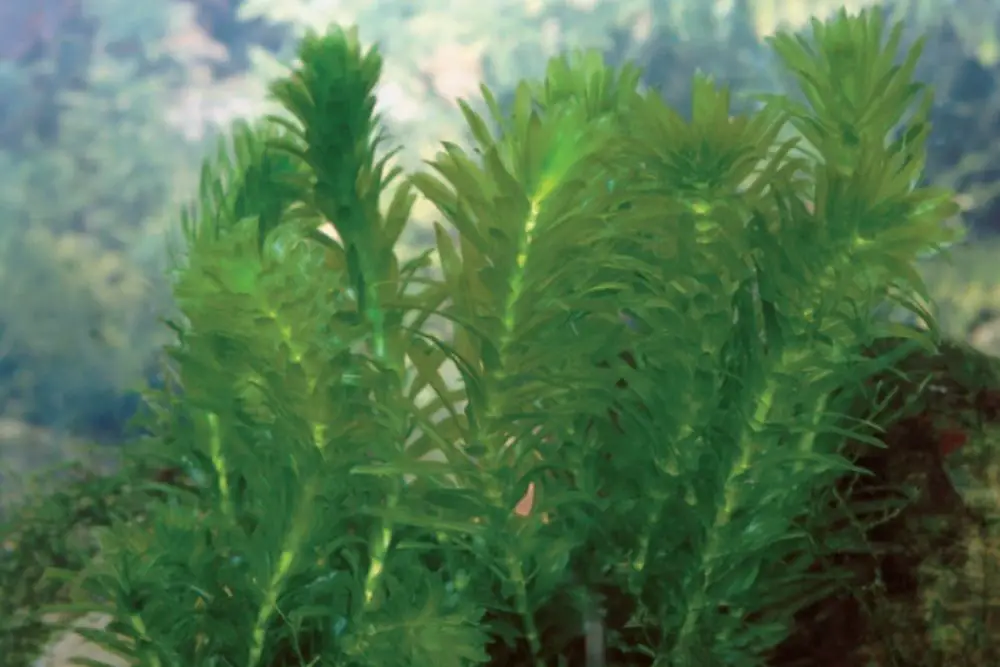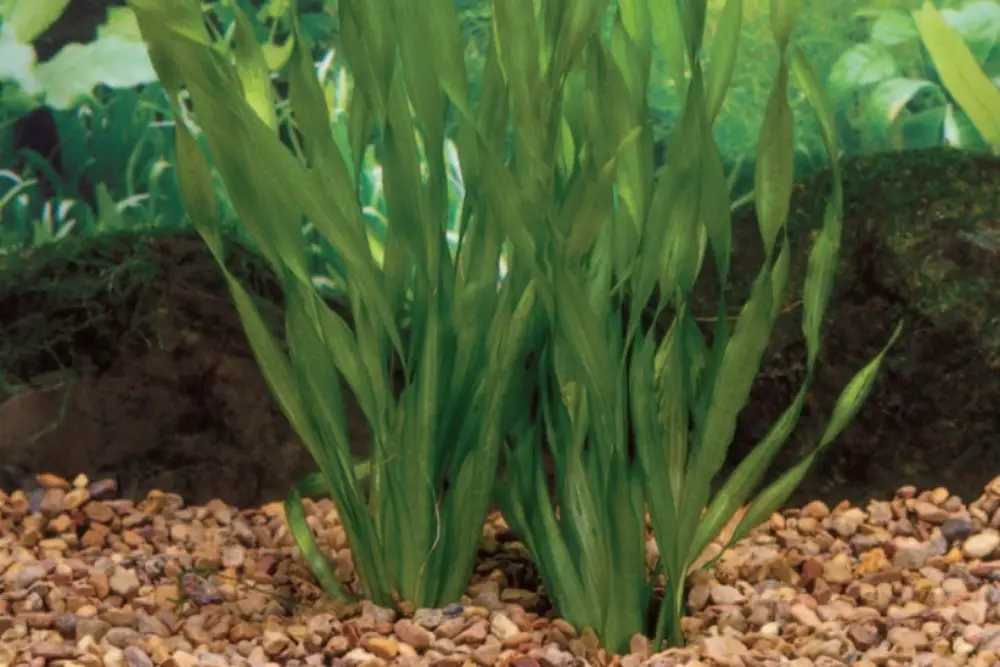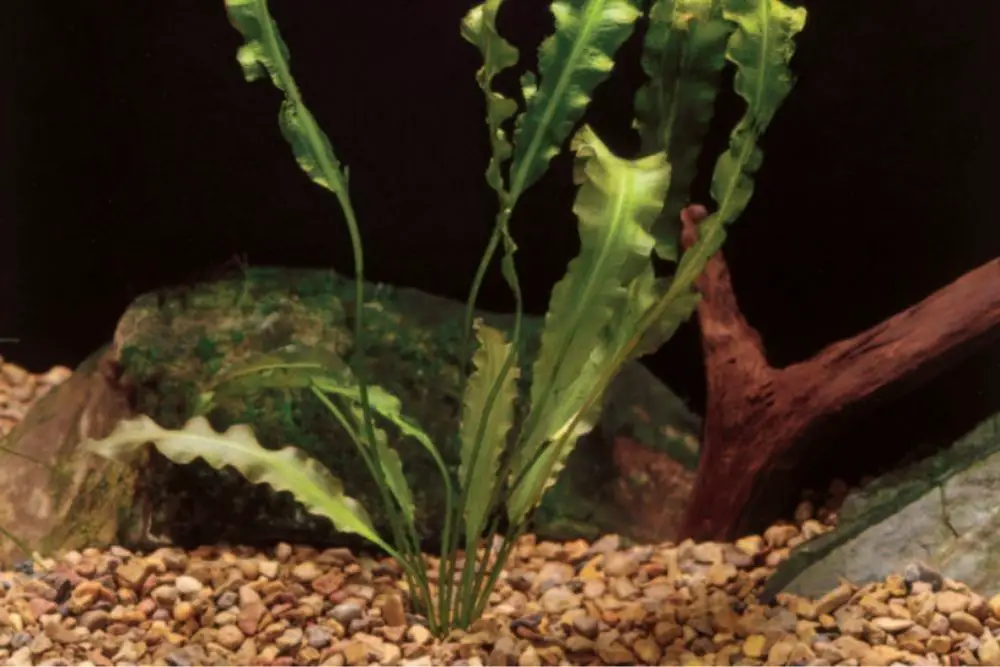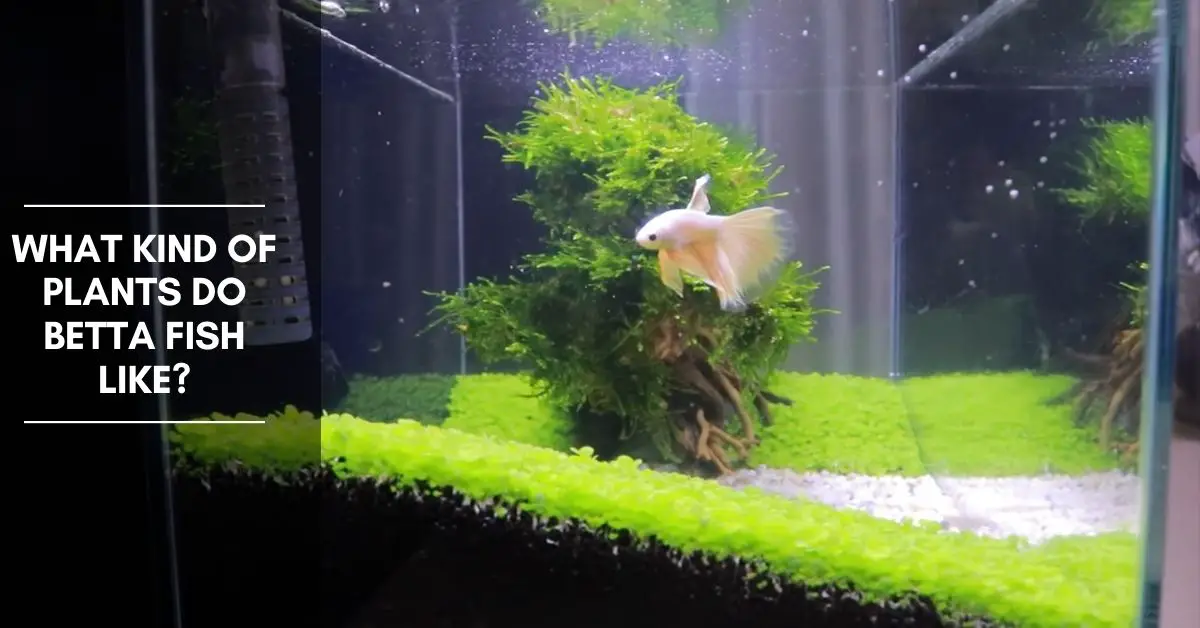There are many good reasons to keep live plants in the Betta aquarium. First, your Bettas will love you for it! Plants provide an interesting and complementary background for all types of tropical fish. The color, finnage, and behavior of your Betta usually intensifies in a naturally planted tank.
Aquatic plants also help keep water conditions optimal. Plants shelter shy Bettas from more aggressive tankmates. They provide shade, helping to reduce algae growth. Plants also help to condition the tank water by removing carbon dioxide, sulfur substances, and nitrogenous wastes. The biological filter converts ammonia into less-harmful nitrate, which the plants, in turn, use for food.
Aquascape Betta Tank
It is much easier to place plants into the aquarium after most of the water has been added than to try to arrange them in a dry tank. A partially full tank will enable you to get a better view of the final arrangement after the plants have spread out.
The substrate in a planted tank should consist of fine gravel or coarse sand, so water can circulate around the plants’ roots. Plants should be spaced far enough apart that they have room to grow without crowding and shading each other.
If you buy cuttings that are too long for your tank, trim the bottom stem to the length you want. Strip the leaves off the bottom to leave 2 inches of bare stem, and bury the stem in the gravel. Roots will develop in a few weeks.
Fluval Plant 3.0 LED Planted Aquarium Lighting, 32 Watts, 24-34 Inches
Boyd Enterprises CPGNnano5 Chemi-Pure Green Nano 5 Pack Aquarium Filtration
5% OffFzone 1.2 Gal Nano Rimless Auqarium Low Iron Fish Tank NovaClear Ultra-White Translucent Glass Verso Series Nano Shallow Pond Levitating Floating Air Aquarium(A20C-H12)
$29.99 (as of July 14, 2024 19:14 GMT +03:00 - More infoProduct prices and availability are accurate as of the date/time indicated and are subject to change. Any price and availability information displayed on [relevant Amazon Site(s), as applicable] at the time of purchase will apply to the purchase of this product.)Rooted plants should be buried just up to the point where the leaves emerge from the root mass. Make sure you do not push the plants too far into the gravel, because deeper planting may cause them to rot. The crown (the area where the leaves emerge from the roots) should be just above, or at, gravel level. Floating plants merely sit on the water surface and pose few problems.
Plants that require attachment, such as the Java fern, can be carefully tied to a piece of driftwood using a nylon fishing line. The fern will attach itself after a few months, and the fishing line can be removed. To begin aquascaping, start by putting the tallest plants near the back of your tank. Next, fill in the center areas with short, bushy plants. Taller bushy plants can be used to hide tank corners, equipment, and odd-looking spaces.
Low-growing species should be placed near the front. Of course, you can vary the design endlessly as you like. It always helps to have the driftwood or rocks in place first. Plant around and behind them to simulate a real underwater scene.
The plants described here are popular aquarium plants that will enhance your Betta tank. Some require specific lighting or water conditions to thrive, but others will adapt to almost any tank.
Anacharis (Elodea densa)

Anacharis is probably the most commonly kept aquarium plant because it is hardy and easy to maintain. It can be kept as either floating plants or as rooted plants. Anacharis are great beginner plants because they adapt very easily, grow quickly, and are easily propagated. They are also good oxygenators. The stems will grow up to 20 inches or more, so they usually need to be kept trimmed.
Amazon Swords (Echinodorus, various species)
Several species collectively known as Amazon sword plants (shown on the first page of this chapter) can be found in aquarium shops. They have broad, sword, or heart-shaped, coarse leaves on sturdy stems. Most grow more than a foot tall and will even bloom above the water surface in a large, brightly lit aquarium. They need plenty of sun and are poor choices for small tanks. One, known in the trade as the pygmy sword plant, remains small and grasslike. With plenty of light it will carpet the bottom and create an extremely attractive display.
Arrowhead (Sagittaria, various species)
With broad to narrow, straplike underwater leaves, arrowhead grows
naturally in tropical to temperate habitats. The name comes from the shape of the leaves that emerge from the water surface in natural ponds. Like sword plants, arrowheads need bright light and plenty of room. They can reach 3 feet or more in height. Most do poorly in acidic aquarium water, developing thin, brown spots on the leaves.
Crypts (Cryptocoryne, various species)
Among the best plants for a small aquarium, the numerous species of crypts live in shallow, warm waters like those inhabited by the Betta. Cousins of the common houseplant philodendron, crypts tolerate lower light levels than many other aquatic plants. Many have colorful foliage, and some readily produce side shoots that can be detached and replanted individually. Some will even bloom, producing flowers similar to a calla lily, when conditions are right.
Eelgrasses (Vallisneria, various species)

The hardy and fast-growing eelgrass species thrive in all kinds of water conditions and do not require intense lighting to reach maximum growth potential. They are perfect plants for the Betta aquarium and the beginning hobbyist. All have thin, elongated leaves that look like green fettuccine. All spread by means of short runners and can form a luxuriant stand when conditions are optimal. Giant varieties grow 2 feet or more tall and look beautiful in a large tank. The most common ones are corkscrew types, in which the leaves spiral upward attractively. Corkscrew tiger eelgrass has dark and light variegations on the leaves, making it quite decorative.
Hornwort (Ceratophyllum demersum)
Hornwort is a floating, vinelike plant that seldom produces roots. The leaves are needlelike, arranged in whorls around the stem. Hornwort grows readily under a variety of conditions but will become stringy and lose leaves if the lighting is insufficient.
Hygro (Hygrophila, various species)
The Southeast Asian hygro family includes some truly hardy plants. The oval, pointed leaves grow in pairs on either side of the stem. If you provide this species with intense light, the foliage will become denser. This plant thrives in a Betta aquarium and is not difficult to maintain.
Java Fern (Microsorium pteropus)

Java fern has large leaves that form a point at the top. It requires moderate lighting conditions. Plants should be attached to a piece of driftwood.
Water Lettuce (Pistia stratiodes)
Water lettuce is a popular floating plant with long, dangling roots. Its leaves provide shade and the roots shelter small fish. It needs plenty of light. Because the leaves can grow upright as much as 6 inches tall, you may need to lower the water level in the tank to accommodate water lettuce.
Water Lilies (Nymphaea, various species)
The water lilies seen in garden ponds get far too large and require far too much sun to do well in most Betta aquariums. However, dwarf varieties can sometimes be found in aquarium shops and make an excellent centerpiece for the Betta tank. The long stems, often purplish in color or with attractive mottling, lift the thin, arrowhead-shaped floating leaves a foot or more to the surface. Well-grown plants will produce their lovely fragrant flowers, looking like miniature versions of garden pond lilies.
Water Sprite (Ceratopteris, various species)
An aquatic fern, water sprite produces thin, lobed, pale green leaves and does well in moderately lit, slightly acidic water. Offspring are produced in the notches between the leaf lobes. When they develop enough roots, the little plantlets can be detached and rooted in the substrate, or allowed to float like water lettuce. Snails will destroy this plant quickly if they get into your aquarium.
Keeping Plants Healthy In Betta Tank
Just like houseplants, aquarium plants need regular care to keep them healthy. Be sure to always trim any dead leaves from the plant before they start to rot and foul your aquarium.
Temperature
Tropical aquarium plants grow well within the same temperature range required by the fish.
Plant Foods
A variety of plant foods are available from your local aquarium dealer. Tablets and liquid feeders can be placed in the gravel near the plants’ roots. Special fertilizer “plugs” can be purchased that will provide nutrition for your plants continuously. A single cutting can be placed in the center of each plug and then buried as a whole unit in the gravel. Some hobbyists swear by a claylike material placed in a layer under the substrate. Just remember not to overdo the feedings or you will end up with a tank full of algae instead of thriving plants.
Lighting
Aquarium plants need at least eight hours of light per day to ensure good health; twelve hours of light is better. Planted tanks generally require more intense lighting than tanks that have only fish, so choose your lighting system appropriately. As a general rule, provide two or more fluorescent tubes that are as long as the tank itself. For a 24-inch tank, this means two 20-watt fluorescent lamps.
Water Conditions
Aquarium plants need the same water conditions that aquarium fish require. They also need water that is free of particulate debris, because cloudy water inhibits light penetration. Also, debris will settle on the surface of the leaves, shading them and looking unsightly.




















